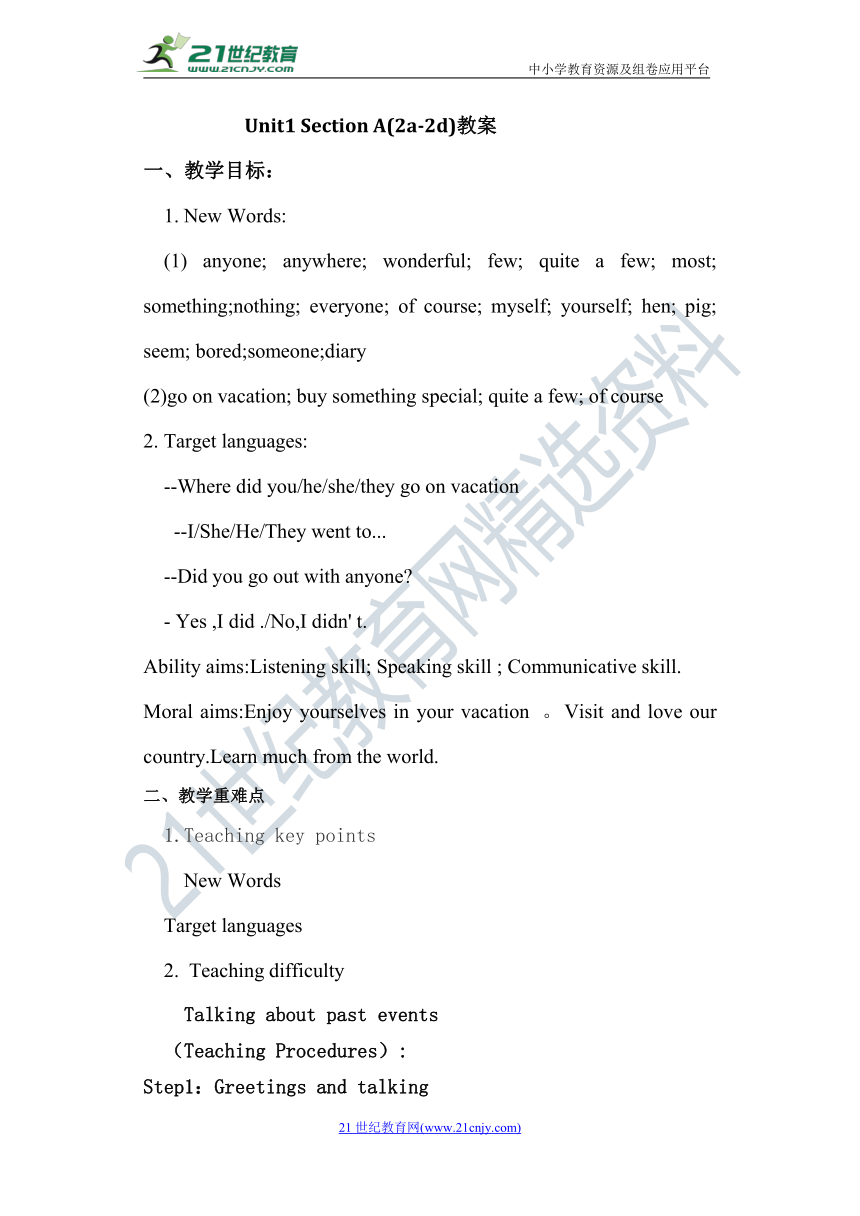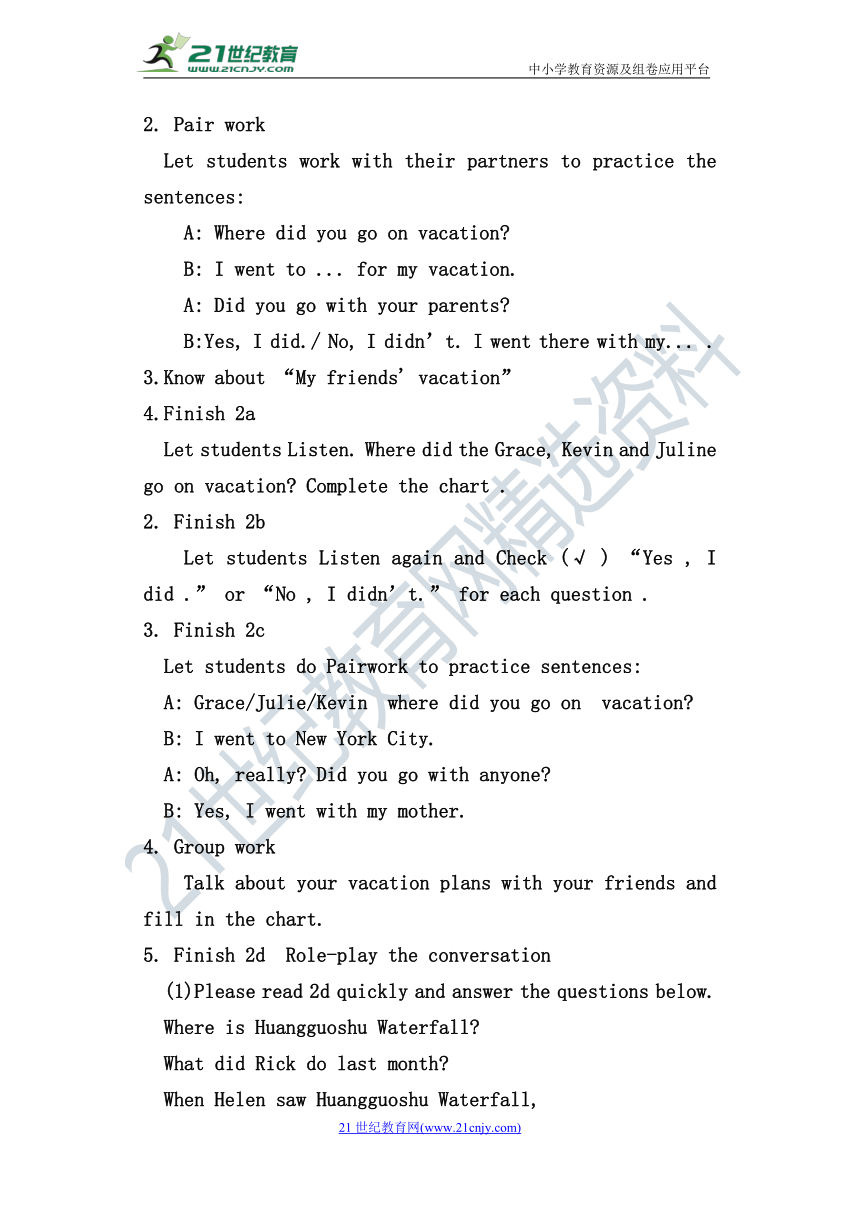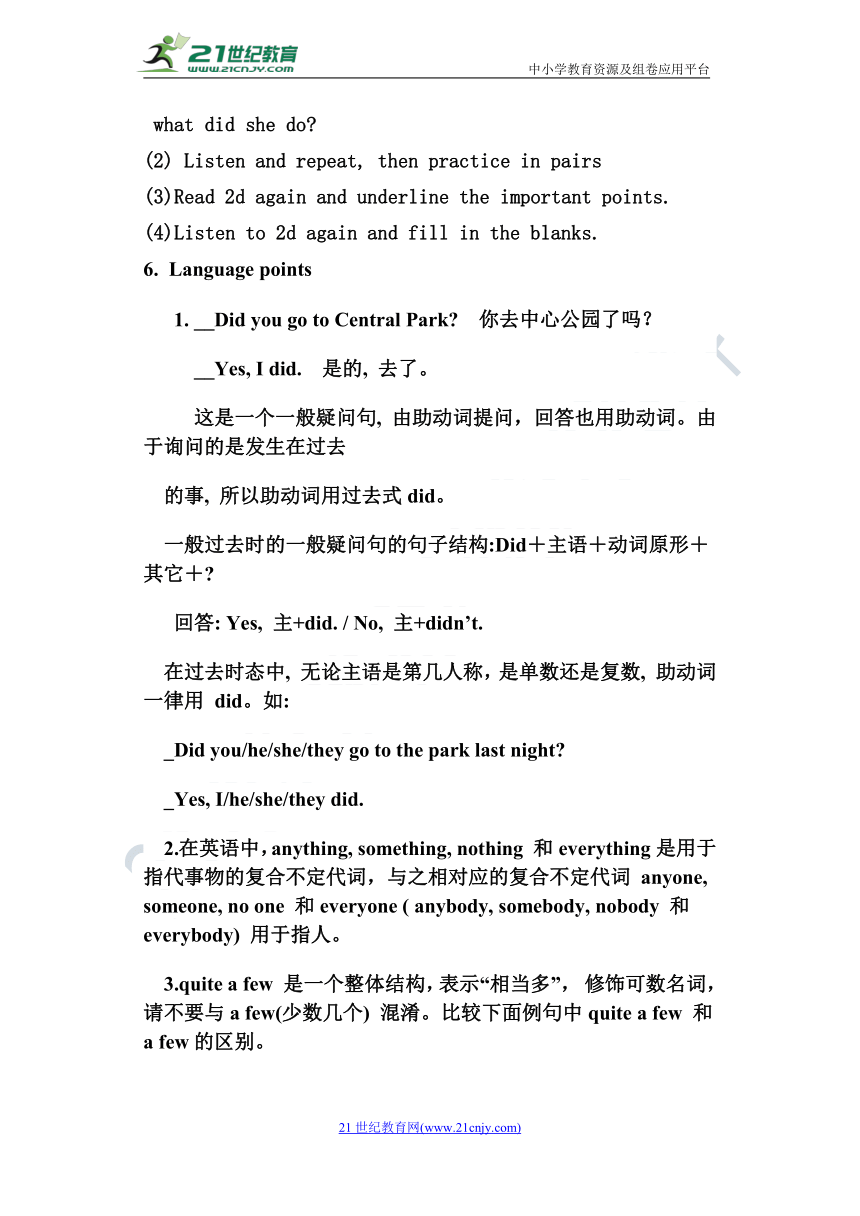【核心素养目标】Unit1 Where did you go on vacation SectionA(2a-2d)教案
文档属性
| 名称 | 【核心素养目标】Unit1 Where did you go on vacation SectionA(2a-2d)教案 |

|
|
| 格式 | doc | ||
| 文件大小 | 1.2MB | ||
| 资源类型 | 试卷 | ||
| 版本资源 | 人教新目标(Go for it)版 | ||
| 科目 | 英语 | ||
| 更新时间 | 2022-08-24 07:31:40 | ||
图片预览




文档简介
中小学教育资源及组卷应用平台
Unit1 Section A(2a-2d)教案
一、教学目标:
1. New Words:
(1) anyone; anywhere; wonderful; few; quite a few; most; something;nothing; everyone; of course; myself; yourself; hen; pig; seem; bored;someone;diary
(2)go on vacation; buy something special; quite a few; of course
2. Target languages:
--Where did you/he/she/they go on vacation
--I/She/He/They went to...
--Did you go out with anyone
- Yes ,I did ./No,I didn' t.
Ability aims:Listening skill; Speaking skill ; Communicative skill.
Moral aims:Enjoy yourselves in your vacation 。Visit and love our country.Learn much from the world.
二、教学重难点
1.Teaching key points
New Words
Target languages
Teaching difficulty
Talking about past events
(Teaching Procedures):
Step1:Greetings and talking
1.教师向学生表示友好的问候,并复习之前所学到的问候语。
2.采用多种自由交际方式,创设浓厚的英语学习氛围与学生进行
Step2 Lead in
Let students enjou a video to lead in the new lesson.
Step3 Review
1.Review the phrases:
(1). stayed at home
(2). went to New York City
(3). visited my uncle
(4). went to summer camp
(5). went to the mountains
(6). went to the beach
(7). visited museums
2. Show some pictures and let students do “Pair work”
to review the sentences:
A: Where did sb go on vacation
B: Sb went to ... .
Step 4 Presentation
Learn the new sentences
展示图片进行师生互动操练新句型:
A: Where did you go on vacation
B: I went to ... for my vacation.
A: Did you go with your parents
B:Yes, I did./ No, I didn’t. I went there with my... .
Pair work
Let students work with their partners to practice the sentences:
A: Where did you go on vacation
B: I went to ... for my vacation.
A: Did you go with your parents
B:Yes, I did./ No, I didn’t. I went there with my... .
3.Know about “My friends' vacation”
4.Finish 2a
Let students Listen. Where did the Grace, Kevin and Juline go on vacation Complete the chart .
Finish 2b
Let students Listen again and Check (√ ) “Yes , I did .” or “No , I didn’t.” for each question .
Finish 2c
Let students do Pairwork to practice sentences:
A: Grace/Julie/Kevin where did you go on vacation
B: I went to New York City.
A: Oh, really Did you go with anyone
B: Yes, I went with my mother.
Group work
Talk about your vacation plans with your friends and fill in the chart.
Finish 2d Role-play the conversation
(1)Please read 2d quickly and answer the questions below.
Where is Huangguoshu Waterfall
What did Rick do last month
When Helen saw Huangguoshu Waterfall,
what did she do
Listen and repeat, then practice in pairs
(3)Read 2d again and underline the important points.
(4)Listen to 2d again and fill in the blanks.
Language points
1. __Did you go to Central Park 你去中心公园了吗?
__Yes, I did. 是的, 去了。
这是一个一般疑问句, 由助动词提问,回答也用助动词。由于询问的是发生在过去
的事, 所以助动词用过去式did。
一般过去时的一般疑问句的句子结构:Did+主语+动词原形+其它+
回答: Yes, 主+did. / No, 主+didn’t.
在过去时态中, 无论主语是第几人称,是单数还是复数, 助动词一律用 did。如:
_Did you/he/she/they go to the park last night
_Yes, I/he/she/they did.
2.在英语中,anything, something, nothing 和everything是用于指代事物的复合不定代词,与之相对应的复合不定代词 anyone, someone, no one 和everyone ( anybody, somebody, nobody 和 everybody) 用于指人。
3.quite a few 是一个整体结构,表示“相当多”, 修饰可数名词,请不要与a few(少数几个) 混淆。比较下面例句中quite a few 和a few的区别。
There are only a few books on the table, but I still have quite a few in the bookcase.虽然桌上只有几本书,但我的书柜里还有很多书。
6. Exercise
Let students work in group and discuss then finish the exercise on the Bb.
Summary
(1)Grammar:
在英语中,anything, something, nothing 和everything是用于指代事物的复合不定代词,与之相对应的复合不定代词 anyone, someone, no one 和everyone ( anybody, somebody, nobody 和 everybody) 用于指人。
(2)quite a few 是一个整体结构,表示“相当多”, 修饰可数名词,请不要与a few(少数几个) 混淆。比较下面例句中quite a few 和a few的区别。
(3)New words: anyone; anywere; wonderful; few; quiet a few; most; something; everyone;
(4) New sentences:
A: Where did you go on vacation
B: I went to ... .
A: Did you go with sb
B: Yes, I did./ No, I didn't.
Step 5板书设计
Unit1 Where did you go on vacation
SectionA(2a-2d)
1. __Did you go to Central Park 你去中心公园了吗?
__Yes, I did. 是的, 去了。
这是一个一般疑问句, 由助动词提问,回答也用助动词。由于询问的是发生在过去
的事, 所以助动词用过去式did。
一般过去时的一般疑问句的句子结构:Did+主语+动词原形+其它+
回答: Yes, 主+did. / No, 主+didn’t.
在过去时态中, 无论主语是第几人称,是单数还是复数, 助动词一律用 did。如:
_Did you/he/she/they go to the park last night
_Yes, I/he/she/they did.
2.在英语中,anything, something, nothing 和everything是用于指代事物的复合不定代词,与之相对应的复合不定代词 anyone, someone, no one 和everyone ( anybody, somebody, nobody 和 everybody) 用于指人。
3.quite a few 是一个整体结构,表示“相当多”, 修饰可数名词,请不要与a few(少数几个) 混淆。比较下面例句中quite a few 和a few的区别。
There are only a few books on the table, but I still have quite a few in the bookcase.虽然桌上只有几本书,但我的书柜里还有很多书。
Step6: Homework
用英语询问你的一位好朋友,她(他)假期去了哪里?看到了什么?并将此对话写在作业上。
A: Where did you go, …
B: I went to…
A: Did you go/see anywhere/ anthing interesting/ special
B: Yes, I did. / No, I didn’t.
HYPERLINK "http://21世纪教育网(www.21cnjy.com)
" 21世纪教育网(www.21cnjy.com)
Unit1 Section A(2a-2d)教案
一、教学目标:
1. New Words:
(1) anyone; anywhere; wonderful; few; quite a few; most; something;nothing; everyone; of course; myself; yourself; hen; pig; seem; bored;someone;diary
(2)go on vacation; buy something special; quite a few; of course
2. Target languages:
--Where did you/he/she/they go on vacation
--I/She/He/They went to...
--Did you go out with anyone
- Yes ,I did ./No,I didn' t.
Ability aims:Listening skill; Speaking skill ; Communicative skill.
Moral aims:Enjoy yourselves in your vacation 。Visit and love our country.Learn much from the world.
二、教学重难点
1.Teaching key points
New Words
Target languages
Teaching difficulty
Talking about past events
(Teaching Procedures):
Step1:Greetings and talking
1.教师向学生表示友好的问候,并复习之前所学到的问候语。
2.采用多种自由交际方式,创设浓厚的英语学习氛围与学生进行
Step2 Lead in
Let students enjou a video to lead in the new lesson.
Step3 Review
1.Review the phrases:
(1). stayed at home
(2). went to New York City
(3). visited my uncle
(4). went to summer camp
(5). went to the mountains
(6). went to the beach
(7). visited museums
2. Show some pictures and let students do “Pair work”
to review the sentences:
A: Where did sb go on vacation
B: Sb went to ... .
Step 4 Presentation
Learn the new sentences
展示图片进行师生互动操练新句型:
A: Where did you go on vacation
B: I went to ... for my vacation.
A: Did you go with your parents
B:Yes, I did./ No, I didn’t. I went there with my... .
Pair work
Let students work with their partners to practice the sentences:
A: Where did you go on vacation
B: I went to ... for my vacation.
A: Did you go with your parents
B:Yes, I did./ No, I didn’t. I went there with my... .
3.Know about “My friends' vacation”
4.Finish 2a
Let students Listen. Where did the Grace, Kevin and Juline go on vacation Complete the chart .
Finish 2b
Let students Listen again and Check (√ ) “Yes , I did .” or “No , I didn’t.” for each question .
Finish 2c
Let students do Pairwork to practice sentences:
A: Grace/Julie/Kevin where did you go on vacation
B: I went to New York City.
A: Oh, really Did you go with anyone
B: Yes, I went with my mother.
Group work
Talk about your vacation plans with your friends and fill in the chart.
Finish 2d Role-play the conversation
(1)Please read 2d quickly and answer the questions below.
Where is Huangguoshu Waterfall
What did Rick do last month
When Helen saw Huangguoshu Waterfall,
what did she do
Listen and repeat, then practice in pairs
(3)Read 2d again and underline the important points.
(4)Listen to 2d again and fill in the blanks.
Language points
1. __Did you go to Central Park 你去中心公园了吗?
__Yes, I did. 是的, 去了。
这是一个一般疑问句, 由助动词提问,回答也用助动词。由于询问的是发生在过去
的事, 所以助动词用过去式did。
一般过去时的一般疑问句的句子结构:Did+主语+动词原形+其它+
回答: Yes, 主+did. / No, 主+didn’t.
在过去时态中, 无论主语是第几人称,是单数还是复数, 助动词一律用 did。如:
_Did you/he/she/they go to the park last night
_Yes, I/he/she/they did.
2.在英语中,anything, something, nothing 和everything是用于指代事物的复合不定代词,与之相对应的复合不定代词 anyone, someone, no one 和everyone ( anybody, somebody, nobody 和 everybody) 用于指人。
3.quite a few 是一个整体结构,表示“相当多”, 修饰可数名词,请不要与a few(少数几个) 混淆。比较下面例句中quite a few 和a few的区别。
There are only a few books on the table, but I still have quite a few in the bookcase.虽然桌上只有几本书,但我的书柜里还有很多书。
6. Exercise
Let students work in group and discuss then finish the exercise on the Bb.
Summary
(1)Grammar:
在英语中,anything, something, nothing 和everything是用于指代事物的复合不定代词,与之相对应的复合不定代词 anyone, someone, no one 和everyone ( anybody, somebody, nobody 和 everybody) 用于指人。
(2)quite a few 是一个整体结构,表示“相当多”, 修饰可数名词,请不要与a few(少数几个) 混淆。比较下面例句中quite a few 和a few的区别。
(3)New words: anyone; anywere; wonderful; few; quiet a few; most; something; everyone;
(4) New sentences:
A: Where did you go on vacation
B: I went to ... .
A: Did you go with sb
B: Yes, I did./ No, I didn't.
Step 5板书设计
Unit1 Where did you go on vacation
SectionA(2a-2d)
1. __Did you go to Central Park 你去中心公园了吗?
__Yes, I did. 是的, 去了。
这是一个一般疑问句, 由助动词提问,回答也用助动词。由于询问的是发生在过去
的事, 所以助动词用过去式did。
一般过去时的一般疑问句的句子结构:Did+主语+动词原形+其它+
回答: Yes, 主+did. / No, 主+didn’t.
在过去时态中, 无论主语是第几人称,是单数还是复数, 助动词一律用 did。如:
_Did you/he/she/they go to the park last night
_Yes, I/he/she/they did.
2.在英语中,anything, something, nothing 和everything是用于指代事物的复合不定代词,与之相对应的复合不定代词 anyone, someone, no one 和everyone ( anybody, somebody, nobody 和 everybody) 用于指人。
3.quite a few 是一个整体结构,表示“相当多”, 修饰可数名词,请不要与a few(少数几个) 混淆。比较下面例句中quite a few 和a few的区别。
There are only a few books on the table, but I still have quite a few in the bookcase.虽然桌上只有几本书,但我的书柜里还有很多书。
Step6: Homework
用英语询问你的一位好朋友,她(他)假期去了哪里?看到了什么?并将此对话写在作业上。
A: Where did you go, …
B: I went to…
A: Did you go/see anywhere/ anthing interesting/ special
B: Yes, I did. / No, I didn’t.
HYPERLINK "http://21世纪教育网(www.21cnjy.com)
" 21世纪教育网(www.21cnjy.com)
同课章节目录
- Unit 1 Where did you go on vacation?
- Section A
- Section B
- Unit 2 How often do you exercise?
- Section A
- Section B
- Unit 3 I'm more outgoing than my sister.
- Section A
- Section B
- Unit 4 What's the best movie theater?
- Section A
- Section B
- Unit 5 Do you want to watch a game show?
- Section A
- Section B
- Unit 6 I'm going to study computer science.
- Section A
- Section B
- Unit 7 Will people have robots?
- Section A
- Section B
- Unit 8 How do you make a banana milk shake?
- Section A
- Section B
- Unit 9 Can you come to my party?
- Section A
- Section B
- Unit 10 If you go to the party, you'll have a grea
- Section A
- Section B
